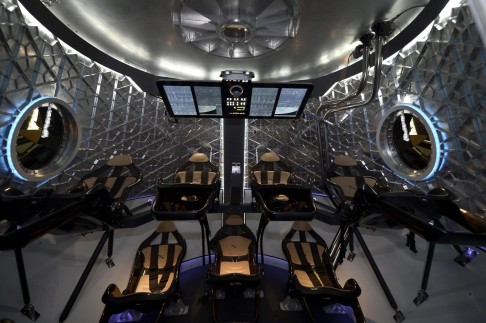Dragon V2 capsule from SpaceX is first entry in race to build successor to space shuttle
Dragon V2 craft is first US has built for manned space travel since end of shuttle programme, with its makers targeting a launch by 2017

A sleek white spacecraft that its makers hope will restore Americans' ability to send people into orbit has been unveiled by the private company SpaceX.
The capsule, called Dragon V2, is the first attempt at building a homegrown US spacecraft to carry astronauts since the space shuttle programme ended in 2011.
"It's all around, I think, really a big leap forward in technology. It really takes things to the next level," said SpaceX CEO Elon Musk at the unveiling ceremony on Thursday.
SpaceX is competing with other companies - including Boeing, Sierra Nevada and Blue Origin - to be the first commercial outfit to take astronauts to space by 2017 and maybe earlier.
"We actually expect to be able to transport crew by 2016, a year before Nasa (the US space agency) needs it," said Musk, a 42-year-old billionaire who is also head of the electric-car maker Tesla Motors. "We feel fairly confident we'll be ready."
Until then, the world's astronauts must continue to rely on Russian Soyuz spacecraft at a cost of US$70 million per seat.
The Dragon V2 - short for version two - was shown for the first time at a packed press conference in Hawthorne, California.

In 2012, SpaceX's Dragon capsule became the first private spacecraft to transport supplies to the International Space Station and return.
Since then, Orbital Sciences has followed with its Cygnus, a capsule shaped like a beer keg that can carry supplies to the space station, but burns upon re-entry to earth's atmosphere.
Musk said a key feature of the Dragon V2 was that it would be able to "land anywhere on earth with the accuracy of a helicopter". The crewed spacecraft will be able to use rocket propulsion and deploy legs to land, instead of using parachutes to make an ocean splash-landing the way the cargo capsule does. But it will still have parachutes that it can use for a landing in case any engine problems are detected before touchdown on earth.
The V2 also carries an improved heat shield and will be able to dock autonomously with the space station, instead of needing the space station's robotic arm to catch it and pull it in. "That is a significant upgrade as well," Musk said.
Musk touted the reusability of the Dragon V2, allowing it to cut back on expensive space journeys. "You can just reload propellant and then fly again.
"This is extremely important for revolutionising access to space," Musk said.
"Because as long as we continue to throw away rockets and spacecraft, we will never have true access to space. It will always be incredibly expensive.
"If aircraft were thrown away with each flight, nobody would be able to fly."
Musk, who is also the co-founder of PayPal, did not say when the Dragon V2's first test flight would take place.
Ever since the US space shuttle programme ended in 2011, the world's astronauts have depended on Russia's Soyuz spacecraft to reach the International Space Station, an orbiting outpost built and maintained by more than a dozen countries.
SpaceX, Boeing, Sierra Nevada and Blue Origin have all received millions of dollars in Nasa funds to help them develop next-generation spacecraft that will carry astronauts to space.
SpaceX has said its crew capsule may be able to reach the ISS with astronauts aboard by 2017.
Meanwhile, Nasa says it is focusing on building a new deep- space capsule that could take humans to Mars by the 2030s.
Additional reporting by Bloomberg